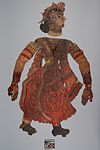tholu bommalata (Shadow Puppet)
About this object
History of use
Puppetry, particularly shadow puppets, is an ancient dramatic form in India mentioned in the Buddhist Jataka Tales of the 3rd century B.C.E. Nowadays modern forms of entertainment, such as the Hindi film industry, have rendered them extinct except for some rural areas in the states of Orissa, Kerala, Andhra Pradesh, and Tamil Nadu. The Andhra Pradesh/Karnataka shadow puppet tradition, compared to the few remaining troupes, are the most extensive and dramatic. Probably originally Maharashtran and maintained by dynasties, such as the Vijaynagars of the 13th and 14th centuries, it now survives as presented by Marathi-speaking puppeteers, commonly called Raoji. These are the largest in size of the Indian shadow puppets.
Iconographic meaning
Represents Sita, symbol of nature and the embodiment of divine splendor, the devoted wife of Rama. She is abducted to Sri Lanka by the demons. This puppet has a removable head, so with another head, doubles for Mandodari, Chief of Queens of demon king, Ravanna. During a South Indian puppet dramatization of the Ramayana an interlude would be included where Mandodari performs the classical Bharat Natayam dance. This dancing puppet, therefore, has many moving parts.
Physical description
A shadow puppet of leather cut out, representing a female figure; dyed black and two shades of red. Costume (part a) is elaborately patterned with black vertical stripes alternating with bands of tiny black incised flowers. Both arms (part a) are jointed at shoulders, elbows, and wrists. Removable head (part b) with a profile face, a nose pin, and numerous flower decorations with an elaborate headdress, does not appear to be matched with the body, which is older, and of a more intricate style. Jointed feet also appear to be replacements.
Materials
